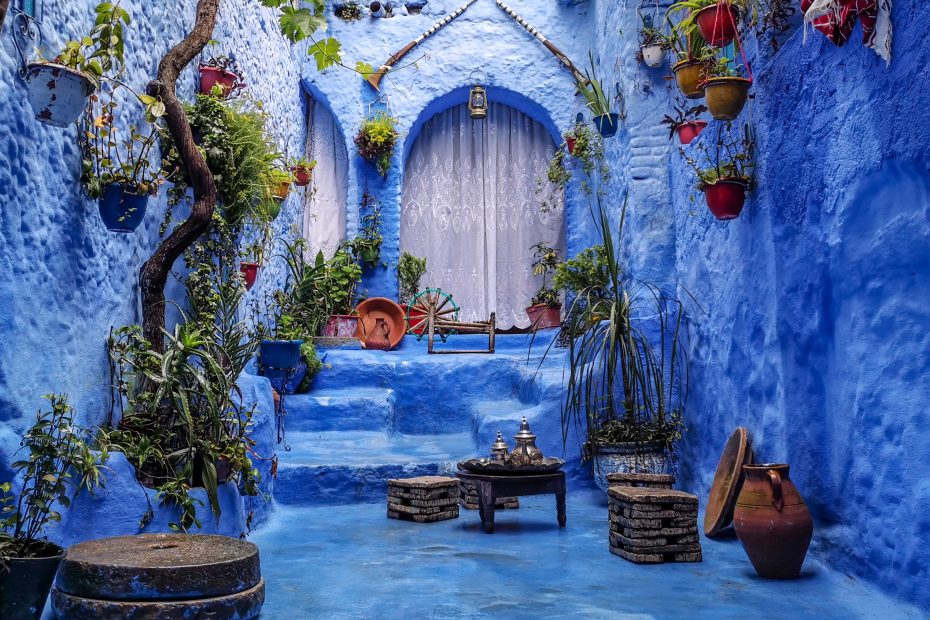Table of Contents
Introduction
Nestledd in the Rif Mountains of northwest Morocco’s lies the striking blue town of Chefchaouen, offering a magical contrast to the country’s red city of Marrakesh. Known as the “Blue City” for its abundance of vivid blue-washed buildings, Chefchaouen is a visual feast and one of Morocco’s most popular tourist destinations. But there’s more to this charming town than its Insta-worthy facades. Let’s explore the history, sights, cuisine and soul of the Blue Pearl of Morocco’s.
History of Chefchaouen
Chefchaouen was founded in 1471 as a refuge from Portuguese invasions, led by Moorish exiles and Jewish refugees. Its meditative qualities and isolated position in the mountains made it an ideal spot for these groups to establish a new community focused on religion. The town’s signature blue color was introduced by the Jewish population, believed to represent the sky and heaven. This blue hue sets Chefchaouen apart from other Moroccan cities and gives it an undeniable magic.
The Alluring Blue Hue
While the origin of the blue buildings remains ambiguous, the most popular theory is that the Jewish population introduced the tradition of using a blue lime wash. One belief is that the blue mimics the sky and serves as a reminder to lead a spiritual life focused on heaven. The color blue also deters mosquitos and has a calming effect. Today the uniform blue provides a cohesive aesthetic that enchants visitors. Walking the steep, narrow lanes is like stepping into a world of blue – everything from doors, windows, staircases and archways is bathed in the calming medley of blues.
Key Sights and Activities
The 15th-century walled medina is the historic highlight, featuring a labyrinth of alleys lined with souvenir stalls bursting with local crafts and cafes emanating with the aroma of Moroccan mint tea. Weave your way to the dazzling central square Uta el-Hammam and admire its pretty mosques and bubbling fountains.
For exceptional views of the old town, hike up to the Spanish Mosque perched on the hilltop. There are also great trails leading into the Rif Mountains, passing through forests and valleys. Visit on a Tuesday or Sunday to browse Chefchaouen’s bustling markets brimming with hand-woven rugs, leather goods, handicrafts and local produce.
Cuisine and Accommodation
Tantalize your tastebuds with heavenly tagines, couscous and harira soup, washed down with a cup of refreshing mint tea. Try local specialties like eggplant caviar and goat cheese. Stay in one of the many converted riads with rooftop terraces overlooking the sea of blue. Intimate hotels with traditional decor are also abundant. Spend the night and rise early to beat the crowds and witness the sunrise illuminating the blue pearl.
Getting to Chefchaouen
The blue city is easily reached by bus from major hubs Fes, Rabat or Tangiers in 3 to 4 hours. Many tourists opt to hire a car for greater flexibility. The nearest airport is Tangier Ibn Battouta, just 2 hours away. Arriving by route through the Rif Mountains builds the anticipation as you weave through small villages before catching your first azure glimpse.
Impact of Tourism
Chefchaouen has boomed in popularity over the past decade, receiving over 500,000 tourists in 2017. While injecting money into the local economy, the flood of tourism also threatens to undermine the town’s historic integrity. Authorities face the challenge of managing visitor numbers and infrastructure expansion while retaining its intimate, traditional ambience. Wandering the quieter corners still offers a taste of local life.
Conclusion
With its pastel-hued old town set amid verdant hills, Chefchaouen deserves its reputation as the Blue Pearl and most photogenic destination of Morocco. Beyond the theatrics, this charming mountain community overflows with history, spirituality and hospitality. Visit Chefchaouen to step into the blue and experience Morocco’s from a new perspective.
Frequently Asked Questions
What is Chefchaouen best known for?
Chefchaouen is best known for its buildings painted in different shades of blue, earning it the nickname the “Blue City”.
When is the best time to visit Chefchaouen?
The best time is during Spring (mid-March to May) when the weather is mild and wildflowers bloom across the hillsides. Avoid the intense heat of summer.
How do you get around in Chefchaouen?
The small medina is best explored on foot. Many lodgings are centrally located. Public buses and taxis are available for excursions to nearby villages.
What is there to do in Chefchaouen?
Top activities include wandering the blue medina, photographing vibrant street scenes, hiking trails in the Rif Mountains, and shopping for Moroccan handicrafts and souvenirs.
What food is Chefchaouen known for?
Try local specialties like goat cheese, tagines cooked in earthenware pots, and delicious harira soup. Mint tea is the iconic drink.
